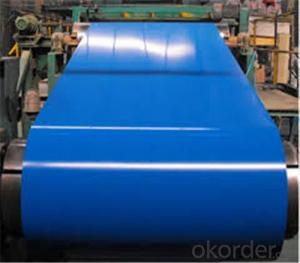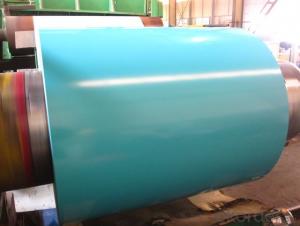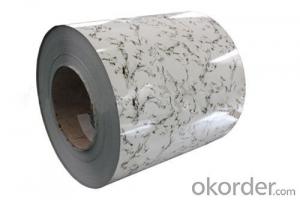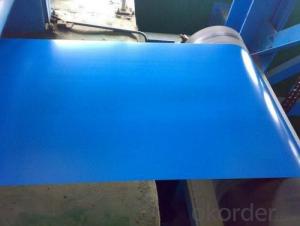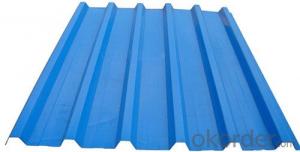prepainted Steel Coils, Hot-dipped Galvanized, RAL System, with good Corrosion resistance
- Loading Port:
- Shanghai
- Payment Terms:
- TT OR LC
- Min Order Qty:
- 25 m.t.
- Supply Capability:
- 30000 m.t./month
OKorder Service Pledge
OKorder Financial Service
You Might Also Like
Product Description
Our Advantages for Blue Color Coated Steel Sheet/coils:
1. Long History, High Credit
-- with over 10 years experience on steel;
2. Rice Rources
-- any standard color, any quantity, any size is available;
3. Sound Quality Control
-- with 20 QC to insure our products is exactly what you want;
4. Cost Control and Lead Time Guarantee
-- with monthly output of over 80, 000 tons from Group factories.
5. Convenient Transportation
-- within 300km from Tianjin and Shanghai Port of China.
Details for Color Coated Steel Sheet/Coils
1 Commodity Name: Prepainted Galvanized Steel Coils(PPGI)
2 Substrate: Cold Rolled Steel Coils
3 Galvanizing Standard: JIS 3302 / ASTM A653 / EN10143
4 Zinc Coating: 60-150GSM(both side)
5 Prepainting: JIS3312/ASTM A755/A755 M/EN10169-1
6 Type of Coating: PE, PVDF, SMP, HDP, RMP ect.
7 Painting Thickness: Top: 18-25microns/ Bottom: 5-7microns
8 Steel Color: RAL Standard
9 Steel Thickness: 0.2-1.2mm
10 Base Material: SGCC, SGCH, DX51D+Z, DX51D+AZ
11 Coil Width: 900~1250mm
12 Coil Weight: 3-5 Ton
13 Coil ID: 508mm or 610mm
14 Package: Standard sea-worthy packing
| No. | Parameter | Description |
| 1 | Commodity | Prepainted Galvanized Steel Coils(PPGI) |
| 2 | Substrate | Cold Rolled Steel Coils |
| 3 | Galvanizing | JIS 3302 / ASTM A653 / EN10143 |
| 4 | Zinc Coating | 60-150GSM(both side) |
| 5 | Prepainting | JIS3312/ASTM A755/A755 M/EN10169-1 |
| 6 | Type of Coating | PE,PVDF,SMP,HDP,RMP ect. |
| 7 | Painting Thickness | Top: 18-25microns/ Bottom: 5-7microns |
| 8 | Steel Color | RAL Standard |
| 9 | Steel Thickness | 0.2-1.2mm |
| 10 | Base Material | SGCC, SGCH, DX51D+Z, DX51D+AZ |
| 11 | Coil Width | 900~1250mm |
| 12 | Coil Weight | 3-5 Ton |
| 13 | Coil ID | 508mm or 610mm |
| 14 | Package | Standard sea-worthy packing |
- Q: How are steel coils coated or painted?
- Steel coils are typically coated or painted using a process called coil coating. In this process, the steel coil is cleaned, treated, and primed before being coated with a layer of paint or a protective coating. This is usually achieved through a continuous automated line, where the coil is unwound, cleaned, coated using various methods such as roller coating or spraying, and then cured to ensure adhesion and durability of the coating. This process allows for efficient and uniform coating application, providing the steel coils with enhanced corrosion resistance and aesthetic appeal.
- Q: I am a beginner (never played before!) and I am going to try to teach myself since I think it is a lovely instrument. I am fourteen-years-old so I am not 'adult-size', haha. Anyway, what is difference between nylon strings and steel strings?Thanks :)
- Make your choice based on the type of music you intend to play. Nylon strings are used primarily for classical, flamenco and folk music. Steel strings are used for pop, rock, blues, country, folk, bluegrass.... Both types of guitar are tuned the same, so you *can* play any style of music on either guitar. The big difference is in the tone. Nylon strings are rich and full...if perhaps a little mellow. Steel strings are twangy and have a bite to the sound. There are differences in the construction and feel of the guitars, but that's not critical to your decision. Match the guitar to the music you intend to play. At 14 yrs old, you are certainly big enough for a full sized guitar....and I'll bet you're still growing, right? Even full sized guitars still vary in the size of the body. Try a few out to see how well they fit your reach.
- Q: How are steel coils processed and treated?
- To ensure the quality and suitability of steel coils for different applications, they undergo a series of steps and treatments. Initially, the coil is uncoiled by removing its protective wrapping and unwinding it. Any defects like cracks or uneven surfaces are then inspected. Next, the coil is cleaned to eliminate dirt, oil, and rust using chemical agents and mechanical scrubbing. After cleaning, it is rinsed and dried to prevent corrosion caused by residual moisture. Once cleaned, the steel coil may be treated based on its intended use. One common treatment is pickling, where the coil is immersed in an acidic solution to remove impurities and scale. This improves the surface finish and prepares the steel for further processing. After pickling, the coil can undergo cold rolling, which reduces its thickness and improves dimensional accuracy. This is done by passing the steel through a series of rollers at room temperature, gradually decreasing thickness and increasing strength. It also improves the surface finish. In some cases, the coil may undergo additional heat treatments like annealing or tempering. Annealing involves heating the coil to a specific temperature and slowly cooling it to relieve internal stresses and improve mechanical properties. Tempering, on the other hand, involves reheating the coil to a lower temperature and rapidly cooling it to enhance strength and toughness. Once the desired processing and treatments are completed, the steel coil may be coated or painted for added protection against corrosion or to enhance its appearance. Coating processes can include hot-dip galvanizing, electroplating, or applying organic coatings like paint or powder coatings. Finally, the processed and treated steel coils are cut into specific sizes or shapes according to customer requirements. This can be done using cutting methods such as shearing, slitting, or sawing. Overall, the processing and treatment of steel coils involve cleaning, pickling, rolling, heat treatment, coating, and cutting processes. These steps are carefully carried out to ensure the quality, strength, and suitability of the steel for its intended applications.
- Q: pros and cons of stainless steel and carbon steel swords
- For display stainless is ok, no maintenance is required, for actual use carbon steel it the way to go, these blades will rust and need to be taken care of.
- Q: looking for a good pocket knife. i keep going through these 440 steel pocket knives with every day work usage. this will be my 4th. even when i use a whetstone they stay sharp for a short period of time but the edge does not last, 440 is too soft! what is a good steel to look for in a pocket knife? also what are some good brands. ive been using gerber and buck sofar. if you could recommend me a few mid/small sized knives i would greatly appreciate it!
- There okorder /
- Q: The strip tower height
- Causes: the strip has a larger snake shape; the take-up device holds the tension; the setting is unreasonable; the strip goes into the coiler; the centering is not good; the coil tension is not set properly.
- Q: What are the dimensions of steel coils used in automotive part manufacturing?
- The dimensions of steel coils used in automotive part manufacturing can vary depending on the specific application and requirements. However, common dimensions for steel coils used in this industry range from 0.5mm to 3mm in thickness and 600mm to 2000mm in width. The length of the coils can also vary, typically ranging from 1000mm to 6000mm.
- Q: How are steel coils used in the production of steel plates?
- Steel coils are a critical component in the production of steel plates. They serve as the primary raw material for manufacturing steel plates. The process begins with the production of steel coils, which are created by heating and cooling molten steel to form thin, flat strips. These coils are then processed further in a rolling mill, where they are passed through a series of rollers to reduce their thickness and increase their length. Once the desired dimensions are achieved, the steel coils are then uncoiled and straightened. This process involves feeding the coils through a machine that removes any curvature or deformities, ensuring the strips are completely flat. The straightened coils are then cut into specific lengths to suit the required dimensions of the steel plates. After being cut, the coils undergo another crucial step known as leveling. This process involves passing the strips through a leveling machine, which eliminates any residual stress or warping that may have occurred during the production process. Leveling ensures that the steel plates have a uniform thickness and are free from any distortions, making them suitable for various applications. Once the leveling process is complete, the steel coils are finally transformed into steel plates. These plates can be further processed based on the desired end-use. They may undergo additional treatments such as heat treatment, surface finishing, or coating to enhance their strength, durability, and corrosion resistance. In summary, steel coils are the starting point for the production of steel plates. They undergo several crucial steps, including rolling, uncoiling, straightening, cutting, and leveling, to transform them into flat, uniform steel plates. These plates can then be further processed and customized for a wide range of applications in industries such as construction, automotive, shipbuilding, and manufacturing.
- Q: How are steel coils used in the manufacturing of HVAC systems?
- Steel coils are used in the manufacturing of HVAC systems as they serve as the main component of heat exchangers, which are responsible for transferring heat between the air and refrigerant. The steel coils provide a sturdy and durable structure for the heat exchanger while also allowing for efficient heat transfer, ensuring optimal performance in heating and cooling processes.
- Q: We are going to build a house with a steel frame.Someone told me today that these houses have problems with humidity.Is that true?Please tell me all you know..
- Steel frame houses are built using a modern method of construction (MMC) with an impressive strength to weight ratio and great design flexibility. The modern steel industry has been making in-roads to residential construction and material price reductions in the 1960 s made it a more affordable option.
Send your message to us
prepainted Steel Coils, Hot-dipped Galvanized, RAL System, with good Corrosion resistance
- Loading Port:
- Shanghai
- Payment Terms:
- TT OR LC
- Min Order Qty:
- 25 m.t.
- Supply Capability:
- 30000 m.t./month
OKorder Service Pledge
OKorder Financial Service
Similar products
Hot products
Hot Searches
Related keywords
